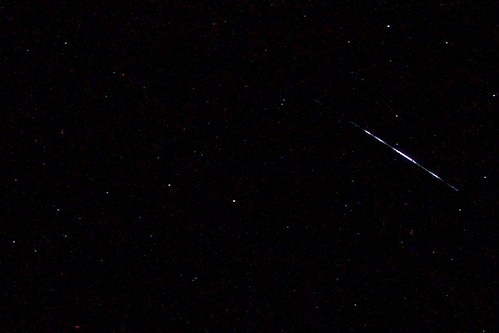Some amazing photographs are appearing on the internet of last night's Perseid meteor shower, such as this photograph below taken by local astronomer Pete Lawrence in West Sussex.

Some amazing photographs are appearing on the internet of last night's Perseid meteor shower, such as this photograph below taken by local astronomer Pete Lawrence in West Sussex.

It is the time of year again when the Earth passes through the debris left behind by Comet Swift Tuttle.
For the last 10 days, the number of meteors (shooting stars) have been greater that usual, and I myself saw a bright meteor through partial cloud a few nights ago. But over the next few nights and mornings (the 11th and 12th), the Earth will be going through the heart of the debris stream. The plot below, from British amateur radio astronomer Dave Swan (see the radio meteor observers website for other contributors), shows the number of meteors, tiny bits of rock less than a millimeter in size, currently burning up over the UK.

As you can see from Dave's data, we see more meteors after midnight than before. But why is this?
Our Earth is orbiting around the Sun at 70,000 mph. In the evening, we are looking backwards, at where the Earth has been. But in the morning, we are looking forward in the direction of Earth's travel around the Sun. If you've ever driven through falling snow in a car, you will realise that it is more exciting looking forwards than looking backwards, and so you see more meteors burning up in the Earth's atmosphere looking into space after midnight than before.
It is also best to go somewhere dark, well away from the light pollution of the cities. The darker your location, the more meteors you will see - and you may see a sight that you will always remember!

Welcome to the Physics & Astronomy Outreach blog, part of the University of Sussex's P&A Outreach site.
This blog contains...
» Previews & reminders of up-and-coming outreach events & activities
» Reviews of past events
» Latest news in Physics & Astronomy - with special relevance to teaching, and the University of Sussex.
We hope you will enjoy reading the blog, and if you do have any ideas or suggestions, please do let us know via our contacts page.